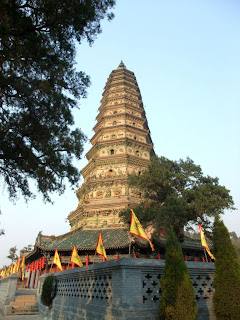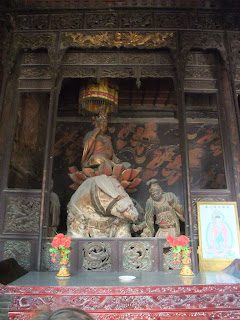

Temple of Guangsheng-si (广胜寺) being 1800 years in history, stands on the southern slope of Mt.Huoshan (霍山) about 17km away from Hongdong town. It comprises of two parts namely Upper Temple and Lower Temple. Upper Temple with Flying Rainbow Pagoda is at the top of mountain and Lower Temple with Water God Temple by its side, is at the foot of the mountain. The Temple site consists of many cultural relics and splendid ancient building structures especially a large scale treasure of frescoes of Chinese traditional operas, that had become a rare reference material for the study of China's dramas.



The Temple Complex with an initial name of Julushe-si (俱卢舍寺)was first built in year 147 during Eastern Han Dynasty. It was repaired and renovated during Tang Dynasty and the name was changed to Guangsheng-si in year 769. In the ensuing years, The temple encountered with warfare, fires and earthquake damages. Large scale of restorations and renovations were done in Ming (1368-1644) and Qing Dynasty (1644-1911) but the structure still contains the characteristic of Yuan architectural style.



Flying Rainbow Pagoda could be seen from far before arriving the gate of Upper Temple. It is the tallest and oldest glazed tile Pagoda that still exists in China.




The existing Pagoda was restored in year 1527 and expanded its base with corridor in year 1622.



The 37 meter high Pagoda covered with bright yellow, green and blue tri-colored glazed tiles has 13 storey and the first floor has corridors surrounded it.




The Pagoda gleams with light on sunny days reflecting off its tiles that are beautifully decorated with Buddhist images, guardians, flowers, birds, dragons, animals and other designs.


The attractive Tower is octagonal in shape, splendid and colorful, especially its lst, 2nd and 3rd floors.



There is nothing much inside The Pagoda but a dark winding stairs leading to its 10th floor.



Look at its beautiful eaves, no one would object that it is an exclusive master piece of glazed tiles Pagoda in China. There are wooden square blocks underneath the eaves that were inserted in between the top of the column, the crossbeam and pillars.


A wonderful piece of work as till today, there is no changes in the tiles colors. They remain as bright as it was built.



This is the most splendid and exquisite Buddhist Pagoda we ever seen. It is a great blessing that it did not collapse in the Linfen 8th level Earthquake occurred during Qing Dynasty in year 1695.




Behind the Flying Rainbow Pagoda in the Upper Temple Complex, there are another 5 major halls inclusive of Amitabha Hall, The Grand Hall, Vairochana Hall, Guan-Yin Hall, Ksittigarbha Hall plus Monk's living quarter and corridors. All were constructed in the architectural style of Yuan Dynasty.



The 3 niches inside the Grand Shrine Hall enshrined a huge wooden image of Buddha Sakyamuni, perfectly calm. Images of Bodhisattva Manjusri and Samantabhadra are by his side and along two sides of the niches, there are 18 bronze Arahats. The Statues of Guan-yin and Amitabha Buddha at the back of niche were not made in Yuan Dynasty but added in later during Qing Dynasty.




Enshrined in Amitabha Halls are The 3 exquisite images of Amitabha Buddha, Guan-Yi and Vajrapani Bodhisattva, which are the master piece of Ming Dynasty. The east wall and screen of the hall are covered with murals. It was once the place where The 4000 volumes of Pingshui version of Buddhist Tripitaka of Huangtong's reign in Jin Dynasty (1115-1234) were kept before they were transferred to Beijing Library for an important material to study the printing history of China.



Vairochana Hall with hip roof and two gables supported by a big crawling beam is a typical architecture of Yuan era.




Vairochana Hall houses images of three Buddhas and four Bodhisattva on the altar that is surrounded by wooden niches. There are 35 bronze Buddha images at the wooden carved alters along the wall and twelve perfect enlightened Bodhisattva at the back of the wall.



Back Hall at Lower Temple Complex which was built in year 1309 enshrined images of three Buddhas, Buddha of the past (Amitabha Buddha), of the present (Sakyamuni Buddha) and of the future (Bhaisajyaguru Buddha) with images of two Boddisattva Manjusri and Samantabhadra (文殊,普贤菩萨). They were the exclusive work from Yuan era (1280-1368). The four walls of the hall were once covered with Yuan frescoes but they were stolen and smuggled out of China in year 1928. They are now kept in one of the art museum in USA. Remaining on the wall now is only a 16 sq.meter area of frescoes that illustrates the 53 journey of visits of the Sudhana (Avatamsakha Sutra). The colorful frescoes shares the same history as the building.




Bronze bell and the remaining murals are very important relics of Guangsheng-si.



The stupa of the venerable monks of virtue.



The Lower temple complex that is mainly made up of Temple gate, Front Hall, Back Hall, Buttress Hall and other structures were built in Yuan Dynasty.



The front main hall.



Temple of Water God, located at the Lower Temple of Guangsheng-si, was originally built to be a center for prayers against the droughts that frequently plagued this region. There are various colorful murals on both walls, depicting the worship ceremony for God of Water, his feats and the local folks praying for water. These murals are mainly from Yuan Dynasty (1271-1368) and have long been considered as an excellent piece of work in depiction of the society of that era. We appreciated very much for the staff for not disappointing us. Though we arrived late, he was still pleased to open the hall's gate and let us go in to eye witness and admire this great piece of treasure frescoes of traditional operas which is the only one left in China (photographing prohibited).




This giant piece of Jade stone (翡翠玉石雕) vividly carved with tradition legends displayed at the entrance of Lower Temple costs millions and millions of dollars. It was donated by one of the Buddhist devotees.


There is a man made pond outside the Temple Gate of Lower Temple complex. It surrounds up the five spouts of HuoQuan Spring that gushes beneath the rock at the foot of Huoshan Mountain. The spouts are neatly with two and three in line in the pond, and never dried up throughout the seasons. Water of HuoQuan comes from Huoshan Mountain and divided into two flows, never fail in breeding the people of two counties.



There were too many relics in the ancient temple of Guangsheng-si, by the time we left, its already sun set.


The Great Chinese Scholar Tree is a place which was believed to be the roots of thousands of Chinese people and its a place where many of them gathered each year to worship the ancestors. Since 1911 from lst to 10th April every year, a festival of seeking roots and praying ancestors was held here. The screen wall that bears the inscription "根 Gen" which means roots was the hand-writing of Zhang Ding, the president of All China Industrial Arts School.



The Great Chinese Scholar Tree is a symbol of leaving one's birthplace against one's will. Beginning of Ming Dynasty (1368-1644), a bureau was set up to monitor immigrants rules and many people were forced to leave their hometown and sent to new settlements all over China. They were so reluctant to leave the place where they lived and when set off to other places, they kept on looking back at their hometown. What they could remember most was The Great Chinese Scholar Tree and the storks nests over it. The site of a great Chinese Scholar Tree with a Tang built Guanji Temple by the side and an ancient broad road ran under it, was the last spot impressed in their mind, when they left their home.



There were 18 times large scheme forced immigrants within a period of 50 years during Ming Dynasty. People were distributed to other 500 counties in 18 provinces, covering Henan, Shangtong, Anhui, places all over the whole China. Before moving to the places allocated, people were gathered at The Great Chinese Scholar Tree in Hongdong which now becomes the roots of billions of Chinese descendants, in mainland and overseas.


At southern part of Hongdong County, there is a 600 sq.meter prison named as Susan Prison which is the only well preserved prison from Ming Dynasty in existence today. It was first built in year 1396 during Ming Dynasty and now its an important place for studying the rules and regulations of ancient panel system in feudal China. Susan was a geisha in Ming Dynasty and a young man named Wang-Jinglong deeply fell in love with her. Susan encouraged him to study hard and go for imperial examination but when he left for the Capital City to take the imperial examination, she was sold to a business man as a 2nd mistress. The business man's first wife had another man and they poisoned him to death and accused Susan as the murderer. Susan was convicted and thrown to the prison, that later carried her name. Wan-Jinglong now an important official at imperial court, came to know the case. He requested his subordinates to overturn her sentence to rescue her from jail and married her. Susan's story was well known throughout China, and had inspired several famous Chinese Opera like Yu-Tang-Chun, The Woman Guards and The Trials on Three Courts.




No comments:
Post a Comment